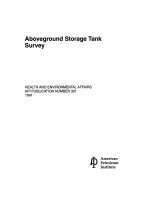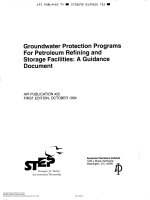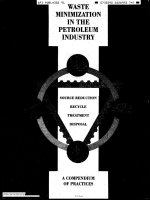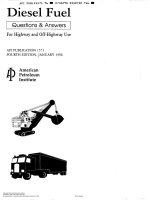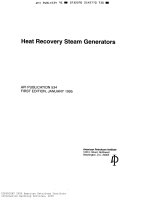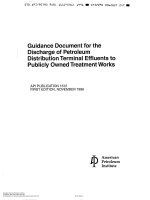Api publ 348 v1 1998 scan (american petroleum institute)
Bạn đang xem bản rút gọn của tài liệu. Xem và tải ngay bản đầy đủ của tài liệu tại đây (3.95 MB, 82 trang )
--`,,-`-`,,`,,`,`,,`---
Copyright American Petroleum Institute
Provided by IHS under license with API
No reproduction or networking permitted without license from IHS
Not for Resale
--`,,-`-`,,`,,`,`,,`---
Copyright American Petroleum Institute
Provided by IHS under license with API
No reproduction or networking permitted without license from IHS
Not for Resale
~
S T D * A P I / P E T R O PUBL 3 4 8 - E N G L
1998
0732290 O b L O L O 3 T O O
Air Toxics Emission Factors
for Combustion Sources Using
Petroleum-Based Fuels
--`,,-`-`,,`,,`,`,,`---
Volume 1
Development of Emission Factors
Using APWSPA Approach
Health and Environmental Affairs Department
API PUBLICATION NUMBER 348
PREPARED UNDER CONTRACT BY:
DAVIDHANSELL
GLENNENGLAND
ENERGY
AND ENVIRONMENTAL
RESEARCH
CORPORATION
18 MASON
IRVINE,
CALIFORNIA
92718
AUGUST 1998
American
Petroleum
Institute
Copyright American Petroleum Institute
Provided by IHS under license with API
No reproduction or networking permitted without license from IHS
Not for Resale
S T D m A P I I P E T R O P U B L 348-ENGL 1998
W 0732290 Ob10104 947
=
FOREWORD
API PUBLICATIONS NECESSARILY ADDRESS PROBLEMS OF A GENERAL
NATURE. WITH RESPECT TO PARTICULAFt CIRCUMSTANCES, LOCAL, STATE,
AND FEDERAL LAWS AND REGULATTONS SHOULD BE REVIEWED.
API IS NOT U N D E R T m G TO MEET THE DUTIES OF EMPLOYERS, -ACTURERS, OR SUPPLIERS TO WARN AND PROPERLY TRAIN AND EQUIP THEIR
EMPLOYEES, AND OTHERS EXPOSED, CONCERNING HEALTH AND SAFETY
RISKS AND PRECAUTIONS, NOR U N D E R T m G THEIR OBLIGATIONS UNDER
LOCAL,, STATE,OR FEDEFUIT., LAWS.
NOTHING CONTAINED IN ANY API PUBLICATION IS TO BE CONSTRUED AS
GRANTING ANY RIGHT, BY IMPLICATION OR OTHERWISE, FOR THE MANUFACTURE, SALE, OR USE OF ANY METHOD,APPARATUS, OR PRODUCT COVERED BY LETTERS PATENT. NEITHER SHOULD ANYTHING C O " E D
IN
THE PUBLICATION BE CONSTRUED AS INSURING ANYONE AGAINST LIABIL-
ITYFOR INFRINGEMENT OF L E T E R S PAmNT.
--`,,-`-`,,`,,`,`,,`---
All rights reserved No part of this work may be reproduced, stored in a retrieval system, or transmitted by any
means,electronic, mechanical,photocopying,recording,or otherwise, without prior writtenpennikswnfrom the
publishex Contact the publisher,API Publishing Services. 1220 L Street, N.W.,Wmhington,D.C. 20005.
CopyrightQ 1998 Amencan Petroleum Instiiute
iii
Previous page is blank
Copyright American Petroleum Institute
Provided by IHS under license with API
No reproduction or networking permitted without license from IHS
Not for Resale
STD.API/PETRO
P U B L 3YB-ENGL
I1998
m 0732290
Ob10105 8 8 3
m
ACKNOWLEDGMENTS
THE FOLLOWING PEOPLE ARE RECOGNEED FOR THEIR CONTRIBUTIONS OF
TIME AND EXPERTISE DURING THIS STUDY AND IN THE PREPARATION OF
THIS REPORT
API STAFF CONTACTS
Affairs Department
Karin Ritter, Health and Environmental Affairs Department
T
i
m Hunt, Health and Environmental
WSPA STAFF CONTACT
Scott Folwarkow, Concord CA
MEMBERS OF THE REVIEW WORKGROUP
Tom Brooks,Marathon Oil Company
Bill Freemen, Shell Exploration and Production
Lee Gilmer, T e m o Research
Arthur Lee, Texaco
Miriam Lev-&, ARCO
Vick Newsom, Amoco Production Company
Janet Peargin, Chevron
Jim Seebold, Chevron Research and Technology
Lee Pooler
Bob Sanford
Robert Verceles
Janice West
Copyright American Petroleum Institute
Provided by IHS under license with API
No reproduction or networking permitted without license from IHS
Not for Resale
--`,,-`-`,,`,,`,`,,`---
EER CONTRIBUTORS
Phiiippe Gauthier
~
~~
STD.API/PETRO PUBL 348-ENGL 1998
= 0732290
ObLOLOb 7LT
m
ABSTRACT
The Western States Petroleum Association (WSPA) and American Petroleum Institute (NI)
sponsored a program to develop air toxics emission factors for combustion devices using
petroleum-based fuels from source test data collected under California Assembly Bill 2588
(AB2588), entitled the Air Toxics Hot Spots Information and Assessment Act of 1987. The
California Air Resources Board (CARB) provided WSPA and API with access to more than 161
petroleum industry combustion source reports, £rom which data were extracted to derive
emission factors. The types of devices represented include process heaters, boilers, reciprocating
intemal combustion engines, gas turbines, steam generators, asphalt blowers, and coke calcinen.
The substances quantified include: trace metals; polychlorinated dibenzo@]dioxinsand
dibenzofurans; polycyclic aromatic hydrocarbons and other semivolatile organic compounds;
benzene, toluene and other volatile organic compounds; fomaldehyde and other aldehydes; and
hydrochloric acid.
Procedures developed in a separate CARB-sponsored program were used to screen and validate
data, eliminating those data points or sets with significant problems andor reporting deficiencies.
Through this process, the best data sets were selected for emission factor development. Emission
factors were developed encompassing all industries in California, and petroleum-industryspecific emission factors.
As a result of this study, air toxics emission factors for combustion devices have been developed
using the best available source testing information. These emission factors can be used by
environmental health and safety engineers to develop more accurate and complete emission
inventories without additional source testing.
This report consists of three volumes: Volume 1 presents emission factors derived specifically
for petroleum industry combustion devices. Volume 2, which presents emission factors derived
for inclusion in the CARI3 database, and Volume 3, providing detailed results of data validation
and statistical comparisons are available from MI’Sweb site: org/ehs/
Publicationd348.hhn.
--`,,-`-`,,`,,`,`,,`---
Copyright American Petroleum Institute
Provided by IHS under license with API
No reproduction or networking permitted without license from IHS
Not for Resale
~
~~
~
S T D - A P I I P E T R O P U B L 3YB-ENGL
1998
0732290 ObLOL07 656
TABLE OF CONTENTS
VOLUME 1
Section
PazJ+e
EXECUTIVE SUMMARY .....................................................................................................
e5-1
1.
INTRODUCTION ..........................................................................................................
1.1
2.
DATA VALIDATION....................................................................................................
2-1
3.
2.1
SCREENING...................................................................................................... 2-1
2.2
DETAILED VALIDATION ...............................................................................
2. 1
2.3
OUTLIER ANALYSIS.......................................................................................
2-4
EMISSION FACTORS................................................................................................... 3-1
3.1
DESIGN AND OPERATING PARAMETERS .................................................
3-2
3.2
MAJOR GROUPS ..............................................................................................
3-4
3.3
AIR TOXCS ......................................................................................................
3-4
3.4
NORMALIZING UNITS....................................................................................
3-6
3.5
DETAILED DATA LISTING ............................................................................
3.6
3.6
TREATMENT OF NONDETECTS...................................................................
3-8
3.7
SUBGROUP EVALUATION ..........................................................................
3-11
3.7.1 External Combustion ............................................................................
3-12
3.7.2 Reciprocating Internal Combustion Engines ........................................ 3-19
3.8
3.7.3 Gas Turbines .........................................................................................
3-25
EMISSION FACTOR TABULATION............................................................
3-25
--`,,-`-`,,`,,`,`,,`---
3.9 COMPARISON OF CARB AND APVWSPA EMISSION FACTORS ..........3-31
REFERENCES .......................................................................................................................... R- 1
APPENDIX A. EXTERNAL COMBUSTION EMISSION FACTORS .................................
A-1
APPENDIX B. INTERNAL COMBUSTIONENGINE EMISSION FACTORS ..................B-1
APPENDIX C. DIRECT-FIRE COMBUSTION EMISSION FACTORS .............................
VOLUMES 2 and 3 ...............................................
Copyright American Petroleum Institute
Provided by IHS under license with API
No reproduction or networking permitted without license from IHS
C-1
ht@://www.apiorg/ehsPublicatìons/348.htm
Not for Resale
STD.API/PETRO
PUBL 348-ENGL
1998
= 0732290
Ob10108 592
LIST OF FIGURES
Figure
.. . .. . . . . ..... .. .... . . . . .. ... . . .. .. .. . 3-7
3- 1
Nomializing Unit Comparison .
3-2
.... ... . .. . .. .... . .... . .. 3-14
External Combustion Fuel Comparison . . . .. . . . . .... . . . . . . .. . . . . . . . . . . 3-17
External Combustion NOx Control Comparison . . . . ... . . . . . . . . . . . . . . .. . . 3-18
External Combustion Emission Factor Group Comparison . . .. . .. . . . . . . . . . . 3-21
Reciprocating Internal Combustion Engine Comparison . . . . ... . . . . . . . . . . . . 3-23
Reciprocating Internal Combustion Engine Emission Factor Group Comparison . 3-26
Gas Turbine Comparison . . . . . . . . . .... . . . .. . .. . .. . . . .. . . .. . . ... . .. . . 3-27
3-3
3-4
3-5
3-6
3-7
3-8
External Combustion System Type Comparison
--`,,-`-`,,`,,`,`,,`---
Copyright American Petroleum Institute
Provided by IHS under license with API
No reproduction or networking permitted without license from IHS
Not for Resale
S T D - A P I / P E T R O P U B L 348-ENGL 1998
m
0732290 O b L O L O 9 429
UST OF TABLES
Table
&gg
......................
ES- 1
External Combustion Emission Factors (lb/MMBtu)
ES-2
...... e5-8
Gas Turbine Emission Factors (IbiMMBtu) .............................
e5-9
Asphalt Blowing and Coke Calcining Emission Factors (ib/MMBtu) ......... e5-10
Summary of Major Validation and Extraction Problems ....................
2-2
Summary of Testing Information Available by System Type and Key Design ...
Parameters .....................................................
3-3
Summary of Testing Information Available by System Type and Substance ..... 3-5
ES-3
ES-4
2- 1
3- 1
3-2
e5-6
Reciprocating InternalCombustion Engine Emission Factors ( l b m t u )
3-5
............. 3-10
External Combustion Emission Factor Comparison Summary ............... 3-20
Reciprocating Internal Combustion Engine Factor Comparison Summary ...... 3-24
3-6
q u i d Fuel-Fired External Combustion Emission Factors: Comparison
3-3
3-4
Listing of Low Sensitivity Tests by System Type and Substance
of APIiWSPA and CARE3 Procedures
3-7
.................................
.......................
3-35
Gas Reciprocating Internal Combustion Engine Emission Factors:
Comparison of APINSPA and CARB Procedures
--`,,-`-`,,`,,`,`,,`---
3-10
3-34
Diesel Reciprocating Internal Combustion Engine Emission Factors:
Comparison of APIIWSPA and CARB Procedures
3-9
3-33
Gas Fuel-Fired External Combustion Emission Factors: Comparison
of API/WSPA and CARF3 Procedures
3-8
.................................
.......................
3-36
Gas Turbine Emission Factors: Comparison of AI?I/WSPA and CARB
Procedures
Copyright American Petroleum Institute
Provided by IHS under license with API
No reproduction or networking permitted without license from IHS
.....................................................
Not for Resale
3-37
S T D - A P I I P E T R O PUBL 348-ENGL 1 9 9 8
m 0732290 O b L O L L O 140 m
ACRONYMS
2s
two stroke reciprocating internal combustion engine
4s
four stroke reciprocating internal combustion engine
AB2588
Air Toxics “Hot Spots” Information and Assessment Act of 1987
Aldehyde Total
acetaldehyde, formaldehyde
APC
air pollution control
API
BTX
American Petroleum Institute
CAAA
Clean Air Act Amendments of 1990
CARB
California Air Resources Board
CATEF
California Air Toxics Emission Factors
CO
carbon monoxide
cocco
cataiyst
CVRG
casing vapor recovery gas
DeNOx (SNCR)
selective non-catalytic NOx reduction
DL
detection limit
EPA
Environmental Protection Agency
EPRI
Electric Power Research Institute
HAP
hazardous air pollutants
HCHO
formula for formaldehyde
HRMS
high-resolution mass spectrometry
LNB
low-NOx burner
LRMS
low-resolution mass spectrometry
LS
low sensitivity data
MACT
maximum achievable control technology
Mgd
MMBtu
thousand gallons
Mmcf
million cubic feet
NC
not used in statistical comparison
benzene, toluene, xylene
million British thermal units
--`,,-`-`,,`,,`,`,,`---
Copyright American Petroleum Institute
Provided by IHS under license with API
No reproduction or networking permitted without license from IHS
Not for Resale
S T D - A P I I P E T R O PUBL 3 4 8 - E N G L
1998
m
--`,,-`-`,,`,,`,`,,`---
NOx
nitrogen oxides
PAH
polycyclic aromatic hydrocarbon
RICE
reciprocating internal combustion engine
S
small data set
SCC
source classincation code
SCR
selective catalytic NOx reduction
SNCR (DeNOx)
Selective non-catalytic NOx reduction
WSPA
Western States Petroleum Association
Copyright American Petroleum Institute
Provided by IHS under license with API
No reproduction or networking permitted without license from IHS
Not for Resale
0732290 O b L O L L L 087
m
STD.API/PETRO
P U B L 346-ENGL 1998
0732290 O b L O L L 2 T L 3
EXECUTIVE SUMMARY
This project was performed with the cooperation of the California Air Resources Board (CARB)
to develop updated air toxics emission factors for combustion sources using petroleum-based
fuels. The emission factors developed in this project will be integrated into CARB's California
Air ToxiCS Emission Factor (CATEF) database. They also may be used by environmental health
and safety engineers to develop air toxics emissions inventories in response to state and federal
requirements. In addition, these emission factors provide an improved scientific basis for
technical and policy decision-making related to the development of new environmental regulations
such as federal National Emission Standards for Hazardous Air Pollutants (NESHAPs)for
petroleum industry sources.
California Assembly Biii 2588 (AB2588),entitled "Air Toxics Hot Spots Information and
Assessment Act of 1987,"requires facilities to provide an inventory of their air emissions for the
purpose of assessing the potential heaith risk to surrounding communities. Source testing to
characterize air toxics emissions is required when recognized emission factors or reliable
engineering estimating techniques do not exist. The results of the source testing performed to
comply with AB2588 were used to develop emission factors, which reiate the quantity of
emissions of a substance to a process-related rate.
DATA VALIDATION
To develop emission factors based on the best available source test results, the petroleum industry
AB2588 source test results were screened using a data validation procedure developed by CARB
for the CATEF database (Hansell, 1996). Using initial screening, detailed validation, and outlier
analysis, this procedure identifies data points and data sets with significant problems and/or
reporting deficiencies. Initial screening identifies source tests without sufficient documentation
for emission factor development and assessment of data quality. The results of 93 of the 161
source tests were eliminated during the screening procedure. Most of the 93 source tests were
eliminated because process rates needed for emission factor derivation were not provided. The
ES-1
--`,,-`-`,,`,,`,`,,`---
Copyright American Petroleum Institute
Provided by IHS under license with API
No reproduction or networking permitted without license from IHS
Not for Resale
STD.API/PETRO
PUBL 348-ENGL
0732290 Ob10113 9 5 T
1998
detailed validation step was conducted on the remaining 68 source tests. Detailed Validation
includes checking to ensure the use of correct samphg and analysis procedures, qualifying
--`,,-`-`,,`,,`,`,,`---
signincant problems such as high field blanks, checking calculations, and evaluating the accuracy
of the test results. The impact of problems identified in the detailed validation process is
quantified by conducting an outlier analysis. Outliers are identified statistically using the Dkon
method. Each outlier is examined to determine if a process andor method problem occm:d as
documented in the results of the detailed validation. if a documented problem occurred, then the
outlier is eliminated.
EMISSION FACTOR DEVELOPMENT
The validated source test data were separated into five groups: external combustion devices,
reciprocating internal combustion engines, gas turbines, asphalt blowers, and coke calciner!;. In
general, the emissions data for each substance in each group were observed to vary over several
orders of magnitude. This variability is due to a combination of measurement uncertainty and
diüerences in the design and operation of devices tested. The variability was reduced, if pclssible,
by identifying design and operating parameters responsible for the variation and further divukg
the group into subgroups, if warranted. Engineering judgment and statistical analysis were used
to determine whether the design or operating parameters had a significant impact on emissions.
Pooling of different system and fuel types within each of the five groups was allowed to jnuease
the quality of the resultant emissions factors. Low sensitivity data also were eliminated from the
subgroup evaluation process and emission factor calculations.
FINDINGS
Key observations and findings from the subgroup analysis are listed below.
External Combustion Devices (Boilers and Process Heaters)
0
Hazardous air poliutant (HAP) emission factors for boilers and process heaim are
similar;
HAP emission factors for external combustion sources fked by natural gas and
process gas are similar;
ES-2
Copyright American Petroleum Institute
Provided by IHS under license with API
No reproduction or networking permitted without license from IHS
Not for Resale
~
~~
S T D O A P I I P E T R O PUBL 3 4 8 - E N G L
1998
0732290 Ob10114 876
Polycyclic aromatic hydrocarbon (PAH) emission factors for liquid-fired
sources are higher than for gas-fired sources;
e
Benzene, toluene, and xylene (BTX) and formaldehyde emission factors for
liquid- and gas-fired sources are similar; and
e
HAP emission factors for boilers and process heaters with and without NOx
emission controls are similar.
Recimocatine Internal Combustion Eneines
e
HAP emission factors for gas- and diesel oil-ñred sources are similar, except that
formaldehyde emissions from diesel sources are lower;
e
HAP emission factors for 2 and 4 stroke sources are similar, except that total BTX
emissions fi-om2 stroke sources are higher; and
e
Rich burn reciprocating internal combustion engines (RICE)have higher total
BTX and lower formaldehyde emissions than lean burn RICE.
Based on these observations, external combustion devices and reciprocating internal combustion
engines were divided into the subgroups shown in Tables ES-1 and ES-2, respectively. The
arithmetic mean emission factor and EPA quality rating are provided in these tables for each
substance. Gas turbines were divided into two subgroups-with and without duct burners (Table
ES-3). Emission factors for direct-fired devices (asphalt blowing and coke calcining) are
provided in Table ES-4. The gas turbine and asphalt blower subgroups were developed from
small data sets and could not be evaluated statistically for signifkance. The coke calcining
emission factors were developed from source testing results on a single unit, therefore, no
subgroup development was possible.
The EPA ratings listed in Tables ES-1 through ES-4 are assigned on a scale of A to E:
EPA Oualitv Ratinq
A - Excellent
B - Above Average
C - Average
D - Below Average
E - Poor
NR - Not Reported
Emission Factors
28
2
12
260
107
25
ES-3
--`,,-`-`,,`,,`,`,,`---
Copyright American Petroleum Institute
Provided by IHS under license with API
No reproduction or networking permitted without license from IHS
Not for Resale
S T D * A P I / P E T R O PUBL 3YB-ENGL
1998
m
~ ~ _ _ _
0732270 Ob10115 7 2 2
m
As shown, most of the emission factors developed in this project have EPA ratings of D or E.
The predominant reason for low EPA ratings is that emission factors were developed from tests
of only one or two sources. Under the EPA rating system, these emission factors can only
receive a D or E raiing even though the measurement data may be of high quality as a result of
the screening and validation procedures. With additional future testing, most of the D-rated
emission factors would move to the A through C categories because these factors were collected
using CARB or EPA source test methodologies. Emission factors with E ratings also were
developed using sound source test methodologies and data points with significant problems have
been identified and eliminated. The E rating was assigned because the source test methodologies
used (mainly CARB Method 428, CARI3 Method 430, and EPA Method 29/CARl3 Method 436
results) have been significantly revised since tests were performed. CARB has not reqked any
retesting for data collected using previous versions of test methods and still considers data
collected using these methods to be valid.
Some discussion of the gas turbine and oil-fired extemai combusfion metals data is warranted
because these data were collected using versions of EPA Method 29/CARB Method 436 which
have been significantly revised to reduce contaminaton. Specifically, Manganese emission
factors for the oil-fired external combustion sources and gas turbines are suspect because of
possible cross-contamination between the HNO,/H,O, and KMnO,/H,SO, imphgers. Arsenic,
Chromium, Copper, Lead and Zinc for oil-fired external combustion sources were detected in
one where the ratio of the blank to sample is greater than 0.10. The gas turbine trip blanks
indicated significant levels of Mercury and Zinc for the sources with duct burners. A complete
assessment of contamination was not possible for the gas turbine data sets because field blanks
were not collected.
REPORT ORGANIZATION
Only Volume 1 is presented here; Volumes 2 and 3 are available fiom MI’Sweb site:
org/ehflublic&nd348.hỵm.
Volumes 1 and 2 describe emission factors
ES4
Copyright American Petroleum Institute
Provided by IHS under license with API
No reproduction or networking permitted without license from IHS
Not for Resale
--`,,-`-`,,`,,`,`,,`---
levels of significance in field blanks compared to the sample. A significant level is defined as
S T D - A P I I P E T R O PUBL 348-ENGL
1998
= 0732290 O b L O l l b
bb9
m
developed specifically for combustion sources using petroleum-based fuels and for CATEF,
respectively. Data collection and validation procedures are summarized in Volume 1 and a
detailed description is provided in Volume 2. Volume 3 provides supporting information,
including detailed procedures used for validation of source test data, validation results, and
detailed statistical comparison results.
This volume (Volume i), which presents petroleum-industry-specific emission factors, is divided
into three sections:
Section 1 - Introduction.
--`,,-`-`,,`,,`,`,,`---
Section 2 - Data Validation. This section summarizesthe data validation process to which the
emission test data were subjected in calculating emission factors of known quality. A more
complete discussion of the data validation procedures can be found in Volume 2.
Section 3 - Emission Factors. This section presents the results of analyses of the impact of
design and operating parameters on HAP emissions from petroleum industry combustion
sources.
ES-5
Copyright American Petroleum Institute
Provided by IHS under license with API
No reproduction or networking permitted without license from IHS
Not for Resale
STD*API/PETRO PUBL 348-ENGL L99ô
0732290 O b L O L L 7 5 T 5
TABLE ES-1. EXTERNAL COMBUSTION EMISSION FACTORS (Ib/MMBa)
Substance
Oi Fired
Emission
EPA
Rating
E
E
E
E
E
E
E
E
E
E
E
E
E
E
E
E
D
Factor
3.5E- 12
1.TE-1 1
1SE-1 1
2.1E-11
3.3E-11
9.3E-11
3.3E-10
623-10
6.OE-11
l.lE-10
1.3E-10
4.3E-11
332-12
6.1E-11
I.4E-10
8.3E-12
7.3E-11
1.3E-06
NA
BalilIIIl
-
6.7E-O6
1 Beryllium
-
-
E
1.9E-06
2.2E-O6
l.lE-06
8.7E-O6
9.5E-06
1.9E-06
E
bioxin/Furan Dioxin:4D 2378
Dioxin:5D 12378
Dioxin:6D 123478
Dioxin:6D 123678
Dioxin:6D 123789
Dioxin.7D 1234678
Dioxin:8D
Furan:4F 2378
Furan5F 12378
Furan5F 23478
'Furan:6F 123478
~ F m : t S123678
Furan:6F I23789
Furan:6F 234678
Furan:TF 1234678
iF~ran:7F1234789
Furan:8F
[dogens
HCl
iletais
Antimony
lhenic
E
-
iCadmium
ICbomium vex)
NA
Chromium (Total)
NA
NA
NA
NA
NA
NA
1.8E-05
1.OE-05
NA
E
NA
2.4E-03
1.8E-04
7.9E-O6
-
'AH
-
NA
C
C
C
C
D
-
-
4.2E-04
1.7E-O7
2.3E-O8
3.E-O8
3.2E-O8
1.4E-O8
ES-6
Copyright American Petroleum Institute
Provided by IHS under license with API
No reproduction or networking permitted without license from IHS
-
Fuel OiI N o. 6
F ed
EPA
Emission
Factor
-g
E
4.3E- 12
E
2.5E-12
2.5E-12
E
E
2.5E-12
E
2SE-12
E
2.1E-Il
E
5.1E-10
E
5SE- 12
E
3.1E-12
E
3.1E-12
2.5E-12
E
1.9E-12
E
2.5E-12
E
3.E-12
E
9.8E-12
E
32E-12
E
4.9E-11
E
Not for Resale
-
-
-
-
-
4.3E-07
E
E
3.3E-05
2.6E-O5
E
E
E
3.9E-O5
7.OE-O8
2.3E-03
E
2.OE-O5
-
-
-
-
-
D
D
D
D
2.1E-09
2.1E-09
1.3E-09
1.4E-09
-
l.lE-04
E
6.OE-O9
D
-
-
Gas Fired
Emission
Factor
-
-
-
-
-
-
-
-
5.2E-07
7.2E-07
5.8E-06
1.3E-O7
1.5E-O6
-
5.7E-O6
4.7E-O6
3.8506
4.9E-06
1.8E-O7
7.5E-06
6.4507
8.8E-07
1.6E-O6
5.8E-O6
1.4E-O3
2.4E-O9
6.5E-09
4.Z-O9
2.2E-O8
5.7E-O8
--`,,-`-`,,`,,`,`,,`---
ktegory
-
S T D m A P I l P E T R O P U B L 348-ENGL 1998
0732290 0610118 4 3 1
TABLE ES-I. EXTERNAL COMBUSTION EMISSION FACTORS (lb/MMBtu)
Substance
htegory
'VOC
Oi Fired
EPA
Rating
Benu>(b)fluoranthene
D
Benzo@+k)fluoranthene
D
D
Benzoopyrene
D
Benzo(g,h,i)pery lene
B e n z a )fluoranthene
D
C
Chrysene
Dibenz(a,h)anthracene
D
Fluoranthene
C
C
Fluorene
D
indeno(lY2,3-cd)pyrene
Naphthalene
C
C
Phenanthrene
C
Mene
C
'PAH Total
2-Chloronaphthene
D
D
2-Mhylnaphỵhalene
E
Benzaldehyde
Ethylbenzene
D
IPerylene
1Phenol
E
NA
Formaldehyde
NA
Aldehyde Total
Benzene
D
B
'Toluene
D
Xylene (Total)
IBTX Total
D
lY3-Butadiene
D
Acrolein
E
Chloroform
D
IHydrogen Sulfide
D
Propylene
~
I
Emission
Factor
5.5E-09
8.1E-O8
3.9E-O9
1.9E-O8
2.3E- 1O
7.5E-08
1.2E-OS
6.9E-08
2.OE-O7
1.9E-08
5.5E-06
132-07
1.2E-O7
7.2E-06
8.2E-O8
2.5E-07
4.7E-O5
-
-
-
-
D
D
D
D
5.8E-O9
6.7E-09
4.6E- 10
2.6E-O8
D
D
D
5.3B08
3.1E-08
3.1E-09
4.0E-07
7.4E-08
-
D
D
D
D
-
2.E-O8
6.5E-07
1.5E-10
7.4E-08
-
-
5.2E-10
7.4E- 1O
-
l.lE-O5
l.lE-O5
2.6E-05
4.1E-O6
3.5E-05
2.9E-06
5.OB05
1.4E-04
3.3E-06
6.OE-O5
-
4.4E-O5
ES-7
--`,,-`-`,,`,,`,`,,`---
Copyright American Petroleum Institute
Provided by IHS under license with API
No reproduction or networking permitted without license from IHS
kuel Oil No. 6 Gas - Fired
F :d
EPA Emission EPA Emission
Rating
Factor Rating Factor
D
A
8.1E-O9
2.7E-08
Not for Resale
-
7.OE-06
133-05
5.2E-O5
-
3.9E-05
-
-
-
A
A
1.3E-O9
1.7E-O8
1.6E-O9
1.5E-O9
8.E-O9
4.8E-08
7.1E-08
3.9E-O7
3.2E-O8
9.8E-09
5.1E-07
A
A
A
A
A
A
A
A
A
-
A
-
-
1.6E-05
-
4.0E-06
NA
1.2E-05
NA
NA
NA
NA
NA
A
5.2E-05
6.6E-05
6.OE-O5
15e-04
A
2.5E-05
5.4E-05
A
1.7E-O5
B
-
-
-
3.4E-O5
-
A
8SE-O5
1.5E-04
I
1
I
*
ES-8
Copyright American Petroleum Institute
Provided by IHS under license with API
No reproduction or networking permitted without license from IHS
Not for Resale
+
--`,,-`-`,,`,,`,`,,`---
n
STD.API/PETRO
P U B L 348-ENGL 1998 m 0732290 O b L O L 2 0 09T m
TABLE ES-3. GAS TURBINEEMISSION FACTORS (Ib/MMBk)
Substance
víais
Cadmium
Chromium (Hex)
chromiinn(Total)
'AH
woc
70C
copper
Lead
Manganese
Mercusr
Nickel
zinc
Acenaphthene
Acenaphthylene
Anthracene
Benzo(a)anthracene
Benzo(b)fluomthene
Benzo&,h,i)pery lene
Benzo(k)nuoranthene
Chrysene
Fluoranthene
Fluorene
Indeno(1,2,3-cá)pyrene
Naphthalene
PAH Total
Phenanthrene
Pyrene
Phenol
Acetaldebyde
Formaldehyde
Aldehyde Total
Toluene
Xylene (Total)
BTX Total
Acrolein
Propylene
Turbine,
Gas/DB=Y
EPA Emission EPA Emission
Factor Rating Factor
Rating
2.9E-06
5.3E-06
E
E
1X - 0 6
1.5E-O6
E
E
5.OE-O5
1.3E-O5
E
E
4.1E-05
1.2E-05
E
D
3.6E-05
2.8505
E
E
4.8E-05
1.3E-04
E
D
4.4E-O6
D
1.5E-O5
D
7.7E-O5
E
1.7E-O4
E
1.2E-04
5.OE-03
D
E
2.2E-08
D
D
3.3E-09
l.lE-08
2.9E-09
D
D
2.5E-O8
3.4E-08
D
D
15e-08
2.8E-09
D
D
2.5E-08
3.3E-09
D
D
1.9E-09
D
2.3E-09
D
l.lE-07
D
D
4.9E-O9
D
9.9E-08
1.2E-OS
D
1.SE-07
1.5E-O8
D
D
1.SE-O9
D
3.7E-O5
7.3E-O7
D
D
3.9E-05
9.1E-O7
D
D
6.4E-O7
6.5508
D
D
1.2E-O7
D
2.3E-08
D
2.2E-05
6.E-O6
D
D
4.1 E-O6
2.E-O5
E
D
3.1E-03
D
E
3.1E-04
1.6E-O4
E
D
3.4E-O4
1.6E-O4
E
NA
3.lE-04
3.7E-O4
NA
E
7.7E-04
D
I .2E-04
1.7E-O5
D
1.6E-O3
D
=
-
-
-
-
-
-
-
-
-
-
-
ES-9
Copyright American Petroleum Institute
Provided by IHS under license with API
No reproduction or networking permitted without license from IHS
-
Not for Resale
-
--`,,-`-`,,`,,`,`,,`---
zategory
~
STD.API/PETRO
PUBL 34B-ENGL
H 0732270 O b L O L 2 L T 2 b
1778
TABLE E S 4 ASPHALT BLOWING AND COKE CALCINING EMISSION FACTORS
(IbWW
-lzrtsnce
ategory
~~
Asphalt, Blow
Asphait, No Blow
Coke Caicining
EPA Emission
Rating
iioxín/Furan
--`,,-`-`,,`,,`,`,,`---
[aloeens
D
D
D
D
D
Dioxin:4D 2378
DioxindD Other
Dioxk5D 12378
Dioxin5D Other
Dioxh6D 123478
Dioxin:óD 123678
Dioxin:6D 123789
Dioxin:6D Other
Dioxin:7D 1234678
Dioxin:7D Other
'Dioxh8D
iFuran:4F 2378
I1Furan:4Fotfier
Furan:SF 12378
Furan:SF 23478
Furan:SF Other
Furan:6F 123478
Furan:6F 123678
Furan:6F 123789
,Furan:6F 234678
Furan:6F Other
Furan:7F 1234678
iFuran:7F 1234789
Furan:7F Other
Furan:8F
HCl
-
2.5E-06
-
-
3.9E-O5
4.5E-05
-
1.2E-O4
8.5E-06
-
ES-1O
Copyright American Petroleum Institute
Provided by IHS under license with API
No reproduction or networking permitted without license from IHS
D
D
D
D
D
D
D
D
D
D
D
D
D
1.4E-O4
1.5E-05
6.1E-05
6.OE-O6
2.9E-05
2.1E-06
6.9E-05
2.9E-05
1.9E-o4
1.4E-O4
1.5E-O4
2.9E-04
1.5E-O3
D
BZUhlII
Beryllium
Cadmium
Chromium (Hex)
Chromium cotai)
Copper
Lead
Manganese
Mercury
Nickel
Phosphorus
D
D
D
D
D
D
D
D
D
D
D
D
D
D
D
D
D
D
Arsenic
Not for Resale
3%-11
4.4E- 1O
2.9E-11
2.7E-10
3.5E-11
4.4E- 11
4.2E- 11
2.1E-10
42E-10
4.1E-10
5.3E-09
4.2E-11
4.3E-10
4.4E-11
4.1E-11
3.8E-10
7.9E-11
7.1E-11
2.9E-11
6.5E-11
4.8E-10
4.8E-10
&0e-1 1
1.8E-10
4.1E-10
D
-
Factor
-
-
TABLE E S 4 ASPHALT BLOWING AND COKE CALCINING EMISSION FACTORS
(lb/MMBai)
Asphalt, Blow
rcle
Emission
Factor
Cont'd.)
AH
VOC
'OC
-
Silver
Thailium
zinc
Acenaphthene
Acenaphthylene
Anthracene
Benzo(a)anthracene
Bem(alpyrene
Benzo@)fluoranthene
Benzo(g,h,i)pery lene
Benzoe)fluoranthene
Chrysene
Dióenz,(a,h)anthracene
Fluoranthene
Fluorene
indeno(l,2,3-~d)pyrene
Naphthalene
PAH Total
Phenanthrene
Pyrene
Ethylbenzene
Phenol
Acetaldehyde
Formaldehyde
Aldehyde Total
Benzene
Toluene
Xylene (m,p)
Xylene (o)
Xylene (Total)
BTX Total
Acrolein
Hydrogen Sulfide
7.9E-o4
-
-
-
-
-
8.1E-04
7.lE-05
1.E-06
3.3E-06
5.OE-O6
-
8.1E-04
-
-
1.9E-03
ES-11
--`,,-`-`,,`,,`,`,,`---
Copyright American Petroleum Institute
Provided by IHS under license with API
No reproduction or networking permitted without license from IHS
Not for Resale
Asphalt, No Blow
Coke Calcining
ele
Emission EPA Emission
Factor Rating
Factor
D
15e-05
D
5.1E-05
D
2.2E-04
5.OE-O4
D
3.m-o4
D
4.4E-O8
D
5.6E-O8
D
5.4E-O8
D
2.óE-08
D
2.4E-O8
D
2.4E-08
2.4E-08
D
2.4E-O8
D
D
3.7E-O8
D
2.4E-08
1.1E-07
D
D
1.=-O7
D
2.4E-08
7.3306
D
D
8.6E-O6
5.m-O7
D
7.9E-O8
D
7.2E-04
4.4505
D
3.lE-O3
4.1E-O6
1.OE-03
D
1.2E-O5
4.2E-O3
1.6E-O5
D
1.OE-O3
D
1.6E-04
D
D
8.9E-05
D
1.3E-04
7.2E-O4
D
1.4E-O3
D
1.OE-03
1.7E-O3
-
-
-
-
-
~
~
~
~
_
_
_
_
~~
S T D = A P I / P E T R O P U B L 348-ENGL 1998
0732290 O b L O L 2 3 A T 9
Section 1
"RODUC??ON
This report presents the results of a project to develop air emission factors for combustion devices
using petroleum-based fuels. The project was performed by Energy and Environmental Research
Corporation (EER) with funding from the American Petroleum Institute (NIand
) the Western
States Petroleum Association (WSPA). The goal was to provide scientifically sound emission
factors using procedures recognized by state and federal regulatory agencies for the purposes of
developing air emission inventories. These emission factors can be utilized by environmental
health and safety engineers to develop more accurate and complete air emission inventories to
comply with state and federal requirements. They also can be used to support scientifically-sound
technical and policy decision-making related to development of National Emission Standards for
Hazardous Air Pollutants (NESHAPs) for petroleum industry sources.
In 1987, the California state legislature passed Assembly Bill 2588 (AB2588),entitled the "Ait
Toxics Hot Spots Information and Assessment Act of 1987." This California law required
industry to inventory air emissions of more than 300 substances (later expanded to more than
700) to assess the potential human health risk to cornunities surrounding emission sources.
Substances include known and potential carcinogens and acutely toxic substances, collectively
known as air toxics. Source testing to characterize air toxics emissions was requjred when
recognized emission factors or reliable engineering estimating techniques did not exist. AB2588
allowed source test results for representative sources to be applied to other similar sources
through the use of emission factors, or "pooled" source testing. In 1989, the Western States
Petroleum Association (WSPA) initiated development of air toxics emission factors specifk to
petroleum industry combustion sources with a pooled testing program. Two rounds of testing
were performed in 1990 and 1992. All source testing was performed under strict guidelines for
test methodology specified by the California Air Resources Board (CARFi). The results of this
testing program were organized into a common database of air toxics emission factors. This
database, which has become known as the WSPA database, provides common and consistent
1-1
--`,,-`-`,,`,,`,`,,`---
Copyright American Petroleum Institute
Provided by IHS under license with API
No reproduction or networking permitted without license from IHS
Not for Resale
STD.API/PETRO
PUBL 348-ENGL
1998
0732270 Ob10324 735 D
emission factors for petroleum industry combustion devices [Hansellet al., 19921. The source
types included in the database are
O
--`,,-`-`,,`,,`,`,,`---
0
Boilers, process heaters, steam generators, internal combustion
engines (gas turbines and reciprocating) with and without NOx and
other air emissions controls; and
Asphalt blowers and coke calciners.
The database includes sources fired with a variety of gaseous and liquid fuels, including natural
gas and petroleum industry process gases (e.g., refinery gas, field gas, casing vapor recovery gas).
The database includes information on sources located in California only. The data may not be
representative of emission factors for sources outside of California. Since California generally has
more stringent air pollutant emission regulations than other states, California sources probably
have more controls for criteria pollutants (e.g., N&, SO,, particulate, etc.) than those in the rest
of the nation.
A key feature of this database is the emphasis placed on the evaluation of data quality. Significant
variations in test and quality assurandquality control procedures were observed among the
various tests, particularly in the first round of pooled source testing. Recognizing the need for
more reliable emission factors, WSPA developed a guidance manual for performing air toxics
tests to ensure high quality data in the second round of pooled source tests as well as any
subsequent tests performed by its individual member companies (Soelberg et al., 1994). As
additional tests were performed by industry over the ensuing years, the database has been
periodically updated to provide more reliable and representative emission factors.
CARB recently completed a project to compile air toxics emission factors from source test data
generated in response to AB2588. Through surveys and Visits to local air quality management
districts throughout the state, source test reports describing 799 air toxics emissions tests for a
wide variety of combustion and non-combustion sources were assembled and used to develop air
toxics emission factors (Hansell,1996). CARB did not develop air toxics emission factors for
1-2
Copyright American Petroleum Institute
Provided by IHS under license with API
No reproduction or networking permitted without license from IHS
Not for Resale
STD.API/PETRO
PUBL 3 4 8 - E N G L
1998
0732290 Ob10125 6 7 1
petroleum industry combustion sources under this effort. Instead, CARB agreed to provide the
American Petroleum Institute (MI)and WSPA access to results fiom 161 petroleum industry air
toxics source tests for derivation of combustion device emission factors. Many of these source
tests had already been evaluated and incorporated into the WSPA database described above. In
return for the additional source test data, API and WSPA agreed to use the CAIU3 data validation
procedures and provide the validated information to CARB for inclusion in the California Air
Toxics Emission Factors (CATEF) database. In response to this agreement, API and WSPA
agreed to use the same rigorous data validation and emission factor development procedures
described in the CATEF report (Hansell, 1996) to develop petroleum industry emission factors.
The results of this effort are described in Volume 2 of this report. The information in Volume 2
will be submitted to CARB for inclusion in the next version of the CATEF report and database.
In addition to developing emission factors for CATEF, MI and WSPA conducted a separate
analysis which is described in this volume. The data review and validation procedures are
identical to those used for CATEF. To improve the quality of emission factors specific to
petroleum industry combustion sources, the CATEF emission factor derivation procedure was
modified:
a
Emission factors fiom selected CATEF source categories were pooled together to
increase the robustness of the emission factors for selected petroleum industry
sources;
Statistical comparisonswere conducted assuming the data are log-normally
distributed; and
--`,,-`-`,,`,,`,`,,`---
Undetected test results collected using low sensitivity analytical techniques were
excluded.
1-3
Copyright American Petroleum Institute
Provided by IHS under license with API
No reproduction or networking permitted without license from IHS
Not for Resale


